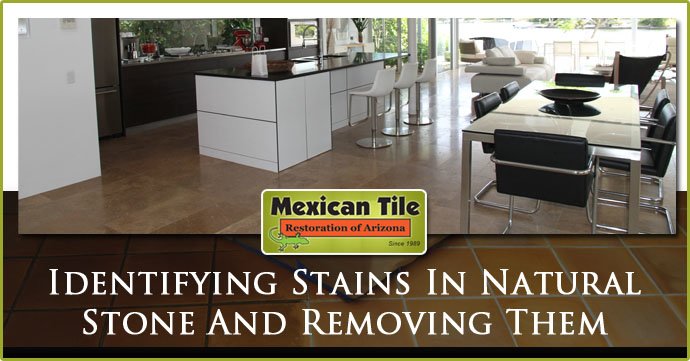If you’re searching for natural stone cleaning tips this guide has been prepared to help you understand how to handle different types of stains. Natural stone is typically more porous and hold onto stains more than other types of flooring. Mexican Tile Restoration professional restores natural stone flooring. If you’d like our help removing any of these stains and restoring the beauty of your natural stone flooring in Phoenix please call 602-370-6082.
Types Of Natural Stone Flooring Stains
Oil based stains such as tar, cosmetics, grease, and cooking oil will make stone appear darker, and the stone will usually have to be dissolved with chemicals in order to get the source of the stain out. Clean the stone using a liquid cleanser (one that is soft), such as mineral spirits, household detergent, acetone, or ammonia.
Organic Stains
Organically based stains from fruits, paper, food, teas, coffee, urine, tobacco, bark, bird droppings, and leaves, can create stains that range in colors from pink looking to brown, and these kinds will usually go away once the source has been taken out. In the outdoors and having the sources of the stains remove, a little normal sunlight and some rain will generally help to bleach out any stains. When indoors, the stain can be cleaned using 12% hydrogen peroxide, combined with a few droplets of ammonia. For the accumulation on a surface from hard water, such as rings and water spots should be buffed using ‘dry 0000′ steel wool.
Inorganic Stains
Stains from inorganic metal stains come from rust, bronze, copper, and iron. Stains that come from iron and rust will range in colors from orange to brown, and it will leave a shape of the object that is staining it, such as bolts, cans, nails, metal furniture, and flowerpots. Whereas, stains from copper or bronze will range in colors from a green to a muddy brown, which is a result of moisture nearby, however, it can be from there being some copper, bronze, or brass being embedded close by as well. One has to use poultice in order to remove stains that are from metal. A stone can become permanently stained if it is from metal, as they are very difficult to remove.
Biological Stains
Stains which fall under the category of being biological, such as mildew, moss, algae, fungi, and lichens, can be clean by diluting ½ a cup of bleach, ammonia, or hydrogen peroxide to 1 gallon of water.
WARNING: Never mix ‘BLEACH’ and ‘AMMONIA’ together! These two chemicals in combination creates ‘TOXIC GAS’. Bleach or hydrogen peroxide (one or the other) can be used to clean light colored stones, and for dark colored stones use acetone or lacquer thinner.
Paint Stains
Use a small amount of lacquer thinner to remove paint stains. The stain can also be removed by gently scraping the paint off the stone using a razor blade. A commercial paint stripper (liquid) should be used to remove heavy paint coverage.
NEVER USE ACIDS OR ANY KIND OF TOOLS WITH A FLAME FOR STRIPPING PAINT FROM STONE!
Fire & Smoke Stains
For ‘fire and smoke damage’ (such as fireplaces that have smoke or fire stains), would more than likely require being thoroughly cleaned in order to bring back their original appearance. You can purchase smoke removal products that are commercially available, which will save on some of the effort that will need to be put into it, as well as on the time it will take.
Acid Type Stains
Calcareous stones (having etch marks) are caused by such things as fruit juices, milk, alcohol, etc., that contain acids being left on the stones surface. Some of these acidity things will leave the etch and a stain, where others may etch without leaving a stain. After removing the stain, apply clear water to the surface and use marble polishing powder (just sprinkle over it). Using a buffing pad or damp cloth rub the powder into the stone with the help of a power drill (low speed), or with a polisher. Continue doing this until the etch mark is gone and the surface of the marble begins to shine. If it consists of deep etching, honing may be necessary. A stone maintenance professional may be necessary for this process.
Efflorescence Stains
Efflorescence is a white powder which can appear on the stones surface, this is done by water that has mineral salts coming from under the stones surface and then it evaporates. As the water is evaporating there is a powdery salt residue left behind. If it is a new installation, simply vacuum up the powder or dust mop. Keep repeating this process each time the stone dries out, until it is all gone. Never use water when removing the powder as this will make the problem even worse. Should this issue continue, the stone contractor needs to be contacted so that they can identify where the moisture is coming from, and they can remove it.
Phoenix Valley Natural Stone Cleaning & Restoration
If you have a home or business that needs natural stone floor cleaning, Mexican Tile Restoration is your source for the highest quality stain removal and cleaning for natural stone flooring. We clean and restore all types of flooring and can do any size of property. If you have questions about how we can help maintain your flooring please give us a call at 602-370-6082.
